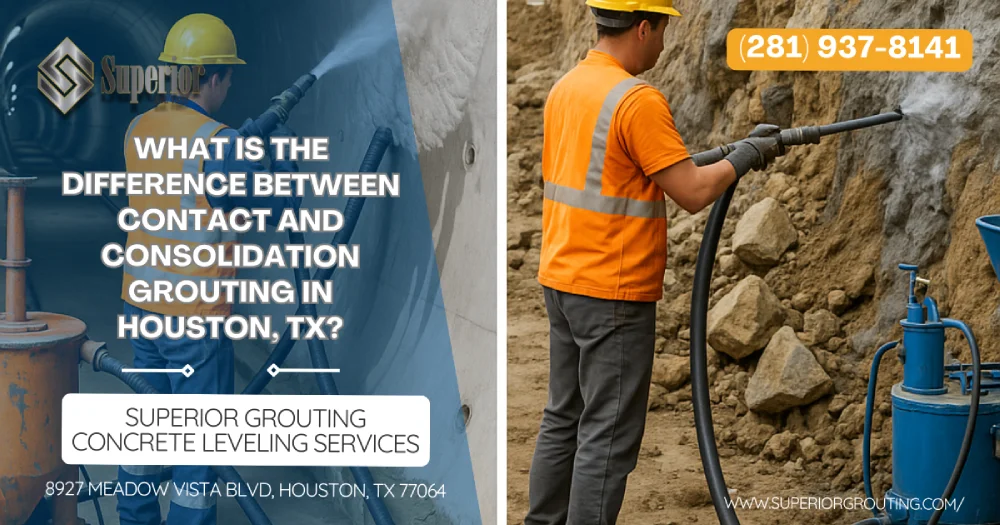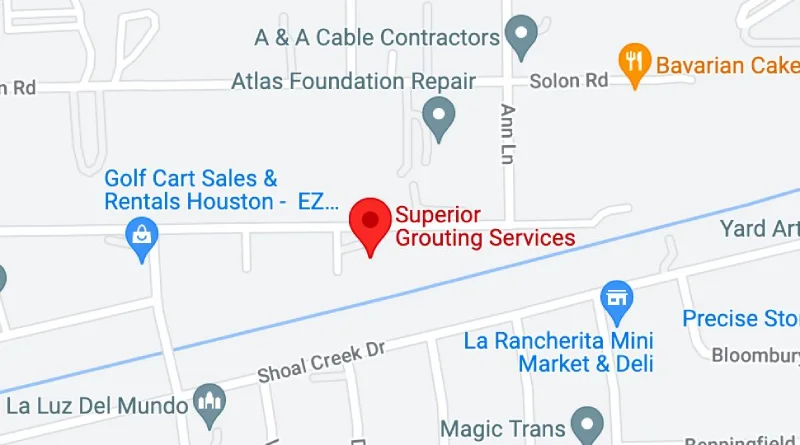What Is the Difference Between Contact and Consolidation Grouting in Houston, TX?

When Gulf-Coast owners, engineers, and general contractors weigh ground-improvement options for major capital projects, two high-value solutions rise to the top: contact grouting and consolidation grouting. Both methods use pressure-injected cementitious grout, yet they solve different problems, protect infrastructure in different ways, and require different execution strategies—especially in the variable soil profile that underlies Greater Houston.
Below, Superior Grouting’s geotechnical specialists break down exactly how each technique works, why it matters to pipelines, refineries, ports, and transportation structures, and how to decide which grouting service best fits your schedule, budget, and performance criteria.
Key Takeaways
- Contact grouting bonds a completed structure—liners, shafts, secant-walls—to the surrounding formation, sealing annular gaps and preventing water or soil migration.
- Consolidation grouting strengthens or “densifies” weak or fractured soil and rock, filling voids and creating grout bulbs that boost strength, stiffness, and overall stability.
- Contact grouting occurs after a structure is installed, while consolidation grouting can take place pre-construction, during construction, or as a remedial measure.
- Houston’s soft clays, cemented sands, and fluctuating groundwater demand tailored mix designs and pressure controls for either grouting method.
- The right Houston grouting contractor will combine lab testing, in-situ verification, and real-time monitoring to keep safety, cost, and schedule on target.
Houston’s Subsurface Realities
Houston may look flat on the surface, but below grade it’s a patchwork of compressible bay mud, low-permeability clays, relic point-bar sands, and indurated Pleistocene deposits. Each layer reacts differently when pressurized grout is introduced. Soft clays tend to squeeze, sand lenses tend to drink grout, and fractured zones can preferentially drain fluids away from the target area. Add high groundwater tables—often just a few feet below grade—and you have a recipe for upward heave, unplanned hydro-fracture, or grout loss if the work is not meticulously engineered and controlled.
That’s why Superior Grouting begins every Houston-area project with a rigorous subsurface investigation: CPTs, borings, permeability tests, and chemical analyses that anticipate sulfate attack. The data inform decisions about water-cement ratio, admixtures, set time, pump staging, and allowable injection pressures. Without that site-specific approach, even the best grout can migrate where it’s not needed or cure before filling its intended voids.
What Is Contact Grouting?
Contact grouting—sometimes called “backfill grouting” or “annular-space grouting”—is performed AFTER a structure is in place. Picture a segmental stormwater tunnel, a secant-pile shaft, or a slurry-wall cutoff trench. The structure is aligned, but a tight annular gap remains between the man-made element and the native ground. Left open, that void becomes a conduit for groundwater inflow, soil migration, differential load transfer, and eventual settlement. Contact grouting eliminates the gap, distributing loads uniformly and sealing pathways for water and contaminants.
How It Works
- Grout ports or pipes are embedded in the structure.
- Low-mobility, low-bleed cement grout is mixed—often micro-fine cement blended with fly ash and a shrinkage-compensating admixture.
- Technicians inject grout in stages from lowest port to highest until refusal pressure is reached or measurable backflow occurs.
- The operation continues around the circumference until a neat “contact seal” encases the structure.
Contact Grouting Applications in Houston
- Segmental tunnel liners under Buffalo Bayou and Brays Bayou outfalls.
- Secant-pile shafts at deep lift stations and pump structures.
- Steel sheet-pile bulkheads along the Houston Ship Channel.
- Precast culverts under heavy-haul corridors at petrochemical plants.
Performance Metrics
- Minimum 100% annular-space fill verified by real-time volume tracking and post-grout GPR scans.
- Maximum contact grout bleed of 2% per ASTM C940.
- Grout shrinkage not to exceed 0.1% at 28 days.
- Unconfined compressive strength (UCS) > 2,000 psi at 28 days if structural interaction is critical.
What Is Consolidation Grouting?
Consolidation grouting—often grouped with “compaction grouting” and “permeation grouting”—focuses on the ground, not a structure. Engineers target loose, fractured, or highly permeable zones that could settle under new loads. They drill a grid of boreholes, inject grout under calculated pressures, and create columns, bulbs, or veins of low-permeability material that bind the ground mass. The result is higher bearing capacity, reduced compressibility, and lower hydraulic conductivity.
How It Works
- Drill pattern—primary holes at 8- to 15-ft centers—penetrates suspect soil horizons.
- Pump medium-mobility grout (0.8–1.2 w/c ratio) in 3- to 5-ft lifts from bottom up.
- Monitor pressure, rate, and take (volume) continuously; stop each lift at refusal pressure or take limit.
- Split-space the grid with secondary, tertiary, or quaternary holes until design criteria—shear-wave velocity, modulus, or volume acceptance—are achieved.
Consolidation Grouting Applications in Houston
- Stabilizing clay lenses beneath refinery processing units and tank foundations.
- Upgrading sands below elevated freeway columns along I-45 and Beltway 8.
- Reinforcing levee embankments protecting critical transportation corridors.
- Sealing karstic voids discovered beneath water-intake structures along the San Jacinto River.
Performance Metrics
- Relative density increase ≥ 20% verified by post-grout CPTs.
- Shear modulus improvement factor ≥ 1.5 over baseline.
- Hydraulic conductivity reduced to ≤ 1×10⁻⁶ cm/s when water cutoff is critical.
- Average UCS of drilled cores ≥ 2,500 psi at 28 days for cementitious consolidation.
Side-by-Side Comparison
Purpose
- Contact Grouting: Bond / seal between structure and host ground.
- Consolidation Grouting: Strengthen and stiffen the ground mass itself.
Timing
- Contact: Always post-construction of the structural element.
- Consolidation: Pre-construction, during construction, or remedial.
Pressure & Mobility
- Contact: Low pressure (typically < 50 psi) to avoid lifting linings.
- Consolidation: Moderate–high pressure (often 100–300 psi) to drive grout into voids and fractures.
Risk Profile
- Contact: Heave or blowout risk is low if ports are sequenced correctly.
- Consolidation: Risk of hydro-fracture if pressures exceed fracture initiation thresholds; requires tight control.
Cost & Schedule
- Contact grouting costs less per cubic yard because volumes are predictable; mobilizations are shorter.
- Consolidation grouting requires investigative drilling, staged injections, and more QA/QC, so the price point is higher but yields long-term settlement control.
Selecting the Right Grouting Service for Your Houston Project
- Define Objectives
Is the priority to seal an annulus around a tunnel or to raise the allowable bearing pressure for a new compressor pad? Objectives steer method selection. - Review Geotechnical Data
CPT tip resistance, SPT N-values, groundwater elevations, and clay mineralogy indicate whether the ground will take grout readily or resist it. - Calculate Allowable Pressures
Superior Grouting models in situ stress, overburden, and fracture gradients. Setting upper-bound injection pressures prevents unintended fracturing or uplift. - Conduct Pilot Tests
A small-scale test section provides real-time insight on grout spread, pressure response, and set times. Savings from optimized parameters often exceed the test cost. - Develop Detailed Specifications
Specs should define mix designs, pump rates, refusal criteria, and verification testing so every stakeholder agrees on “done right.”
Implementation Best Practices
- Use sulfate-resistant cement or slag blends to combat corrosive Gulf Coast groundwater.
- Stage injection pressures; begin low, ramp up slowly, and watch differential gauges tied into a data-acquisition system.
- Add non-shrink admixtures for contact grouting where voids are tight and temperatures vary.
- For consolidation grouting, consider thixotropic additives if you need the grout to stay put in near-vertical fractures.
- Always back-flush hoses and lines to avoid cross-contamination between mix batches.
Quality Assurance & Verification
Superior Grouting employs ASTM and USBR-accepted methods to document performance:
- Pressure/Volume Logs: Digital records of every second of pumping.
- Surface Surveying: Optical levels or robotic total stations to detect heave or settlement.
- Down-hole Geophysics: Sonic logging or cross-hole tomography confirms grout columns and detects voids.
- Coring & Lab Tests: Extract hardened grout/soil samples for UCS, modulus, and permeability testing.
Why Choose a Specialized Houston Grouting Contractor?
Grouting is not a commodity service. It blends geotechnical engineering, high-pressure pumping, materials science, and real-time field judgment. A qualified Houston grouting company will provide:
- PE-stamped mix designs tailored to local soils.
- Pump operators with OSHA 30 and HAZWOPER certifications for industrial sites.
- Fleet redundancy—backup pumps, generators, and mixers to keep critical-path schedules intact during hurricane season.
- Project history on similar Gulf Coast industrial facilities, ports, and transportation assets.
Conclusion
In Houston, contact grouting and consolidation grouting share the same raw ingredient—cementitious grout—but serve very different missions. Contact grouting seals and supports completed structures; consolidation grouting transforms marginal ground into a stable foundation for heavy civil and industrial assets. Armed with a robust geotechnical model, carefully selected injection parameters, and an experienced grouting contractor, owners can deploy either technique with confidence, ensuring long-term durability, reduced maintenance, and optimal lifecycle costs for critical infrastructure across Southeast Texas.


